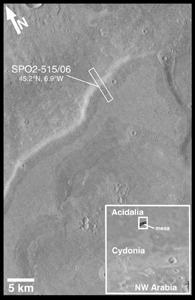

MGS MOC Release No. MOC2-183, 1 October 1999


If the northern plains of Mars had ever been the site of a vast ocean, then any highlands that protrude above these plains might be expected to exhibit shorelines. The somewhat curved, flat-topped mesa seen in Viking image 026A72 (above, left) is bounded by a dark band. Prior to the Mars Global Surveyor (MGS) mission, this mesa was interpreted by some researchers as having been a possible island in an ancient, northern plains ocean. The dark band was interpreted to be a shoreline resulting from the action of waves lapping against the island's coast.
A high resolution image of the banded mesa--located on the Acidalia plains around 45°N, 7°W--was acquired by the MGS Mars Orbiter Camera (MOC) in August 1998, over twenty years after the Viking image was taken. A subframe of this image--SPO2-515/06--is shown on the right. In the MOC image, the dark band resolves into a series of narrower bright and dark bands. Each band has a slightly different texture and brightness. Furthermore, what appeared to be a sunlit escarpment bounding the north side of the mesa in the Viking image appears in the MOC image to be only a shallow slope rather than a scarp or cliff. The origin of the different bands is not known, but the most likely explanation that would be consistent with other MOC observations of Mars is that the mesa consists of layered rock, and that each band is an outcropping of a different layer of this rock. The different textures would result from the differing resistance to erosion of each layer. Both images shown here are illuminated from the left.
For a higher-resolution view of the context image (740 Kbyte), CLICK HERE.
For a higher-resolution view of the narrow angle camera image (840 Kbyte), CLICK HERE.
Malin Space Science Systems and the California Institute of Technology built the MOC using spare hardware from the Mars Observer mission. MSSS operates the camera from its facilities in San Diego, CA. The Jet Propulsion Laboratory's Mars Surveyor Operations Project operates the Mars Global Surveyor spacecraft with its industrial partner, Lockheed Martin Astronautics, from facilities in Pasadena, CA and Denver, CO.
Contact: info@msss.com